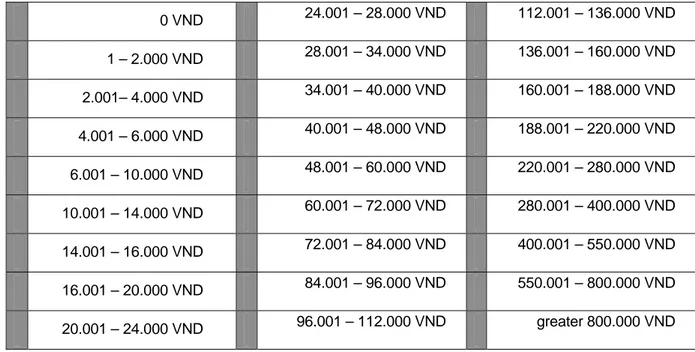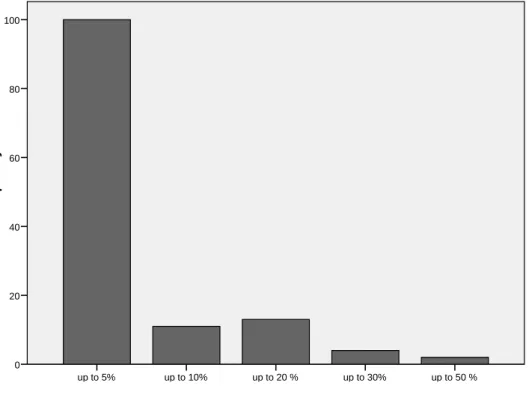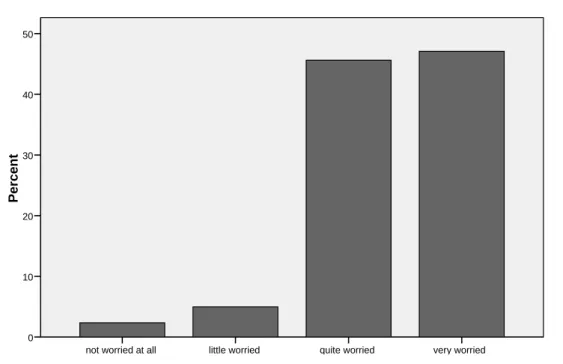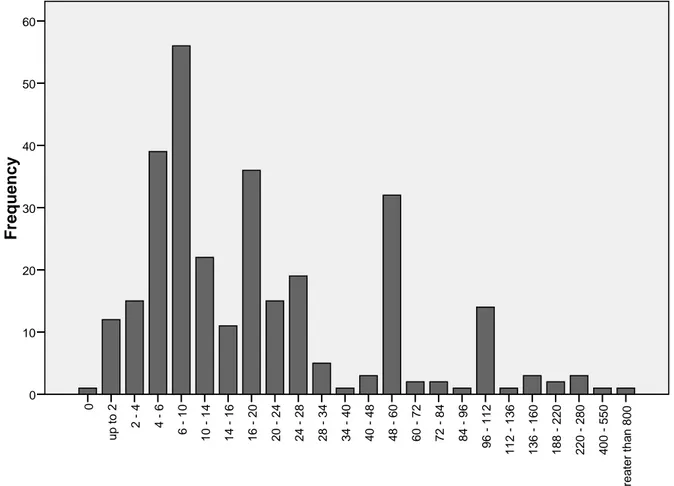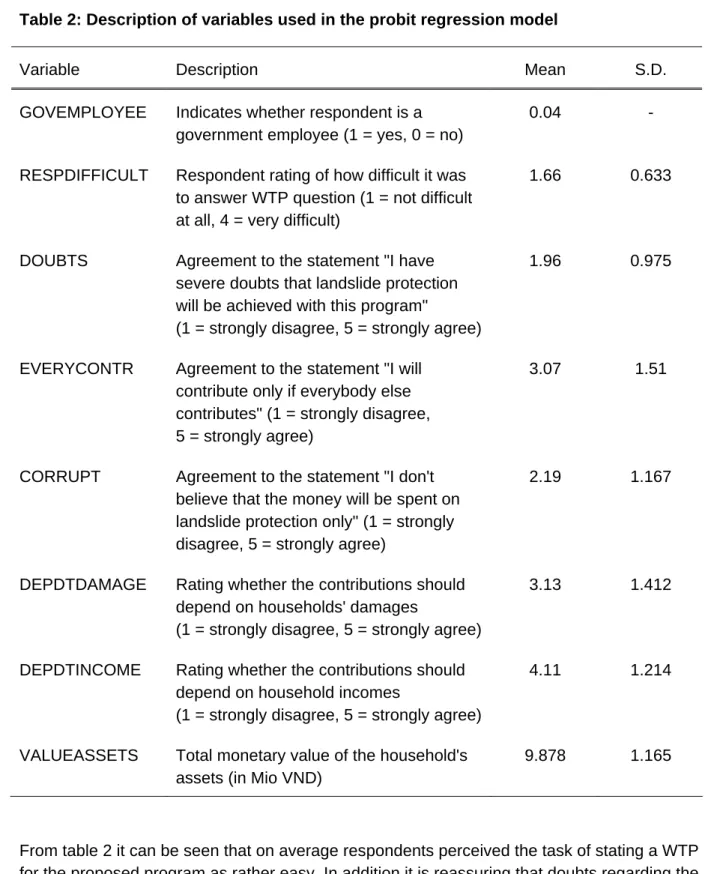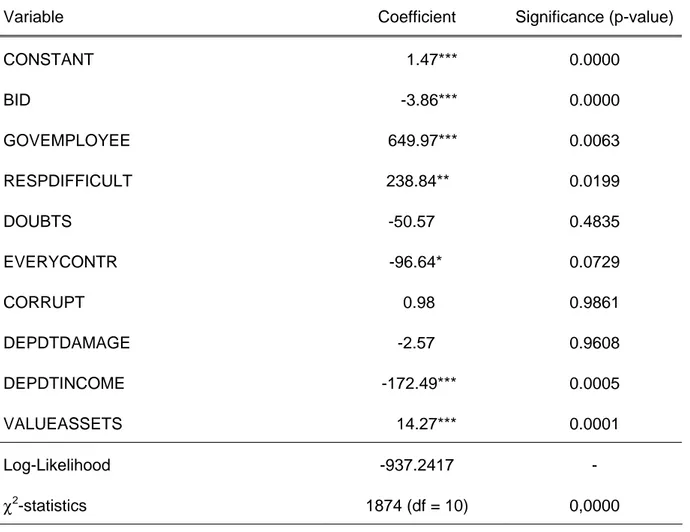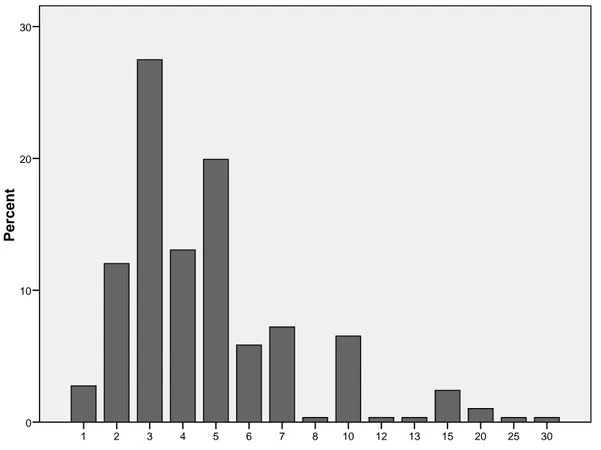Landslides in mountainous regions of Northern
Vietnam: Causes, protection strategies and the
assessment of economic losses
by
Michael Ahlheim, Oliver Frör, Antonia Heinke, Alwin Keil,
Nguyen Minh Duc, Pham Van Dinh,
Camille Saint-Macary and Manfred Zeller
Nr.298/2008
Landslides in mountainous regions of Northern
Vietnam: Causes, protection strategies and the
assessment of economic losses
by
Michael Ahlheim
1), Oliver Frör
1), Antonia Heinke
1),
Alwin Keil
1), Nguyen Minh Duc
2), Pham Van Dinh
2),
Camille Saint-Macary
1)and Manfred Zeller
1)1)
University of Hohenheim, Germany
2)
Hanoi University of Agriculture, Vietnam
Abstract:
Landslides are a severe problem during the rainy season in many mountainous regions in Asia where forests have been cut so that mountain slopes are destabilized. In this study we analyze the extent and causes of landslides in a mountainous area in Northern Vietnam as viewed from the perspective of the concerned population. We also scrutinize the ideas of these people regarding suitable landslide protection measures and their willingness to contribute to the practical implementation of these measures. It shows that nearly all people living in this area feel highly concerned about the frequent landslide events and that they support the idea of government programs to mitigate the danger of future landslides. We measure the utility they expect from such a landslide protection program, i. e. the social value of such a program, in terms of their willingness to contribute personally to its implementation. Since budgets are tight in these rural areas where subsistence farming still prevails we also analyze the possibilities to measure these expected utility gains in terms of people's willingness to contribute working time instead of money to the proposed landslide protection program. The prospect of employing such an alternative means of contribution is, however, seen rather critical.
1. Introduction
Every year in the rainy season between June and September people in the mountainous regions of Northern Vietnam suffer from the consequences of extensive landslides. Roads are blocked for days, fields are devastated, houses are destroyed and wide areas are flooded in the valleys. In this paper we scrutinize the causes of these landslides from the perspective of the people living in the endangered regions and we also try to find out their ideas regarding landslide protection strategies as well as their willingness to contribute personally to improve the situation.
In countries like Vietnam where public means are still scarce while there is an immense need for public projects to improve the infrastructure of the country in order to trigger its economic development it seems to be especially important to get people involved in public activities. If people oppose these activities silently or are just not interested implementation costs rise dramatically leading to inefficiencies that make such projects unaffordable for a still poor country like Vietnam. Therefore, our project aims at the assessment of people's attitudes towards a possible landslide protection program and the possibilities to get them involved. The paper is organized as follows: Section 2 describes the characteristics of the research site and the setup of the empirical survey carried out in Yen Chau district in Northern Vietnam. The results of this survey are presented in section 3 followed by a discussion of the main descriptive results of the surveys and the determinants of households' willingness to pay for landslide protection in Section 4. Section 5 contains a short summary and concludes the paper.
2. The survey
Our research site is Yen Chau district in Son La province located about 250 kilometers West of Hanoi. The National Road No. 6 from Hanoi to Son La continuing to Dien Bien Phu which leads through Yen Chau is especially endangered by landslides during the rainy season. In order to learn how people feel about these landslides and their consequences we conducted an in-person survey with a random sample of households covering both lowland and upland locations in Yen Chau district.
Before the survey, 50 in-depth interviews were conducted with representatives of the different social and economic groups in Yen Chau district in order to get a first impression of people's experiences with and their attitudes towards landslides. The respondents in these interviews comprised members of the People's Committee, Communist Party officials, members of the district administration, village heads, merchants, truck drivers, farmers, farm workers etc. On the basis of the results from these interviews a first questionnaire was developed. This questionnaire was tested and continuously further developed in two waves of pretests with a total of 65 completed face-to-face interviews. Finally the main survey was conducted on the basis of the revised questionnaire in a random sample of private households in 20 villages within Yen Chau district. In a first step, the villages were randomly
selected from a sampling frame comprising all villages of the district1 using the Probability
Proportionate to Size (PPS) method. In a second step, 15 households were randomly selected in each of these villages using updated village-level household lists as sampling frames. Since the PPS method accounts for differences in the number of resident households between villages in the first step, this sampling procedure results in a self-weighing sample. Altogether, the main survey comprised 297 completed face-to-face interviews. The questionnaire was attached to a much more extensive general questionnaire in which detailed data concerning the economic and social situation of households in Yen Chau was assessed. The majority of the interviewed households (ca. 75 %) belong to the ethnic group of the Black-Thai which are the dominating ethnical group in this region, however a minority within the whole of Vietnam. The rest of the interviewed households belonged to the H'mong and the Kinh. Most of the heads of the interviewed households were farmers (84 %) who were able to read and write (77 %). Only very few were self-employed (2 %), government employees (4 %), or salaried workers in the non-agricultural sector (1 %), among others. This distribution of occupations is typical for this region.
In our survey we used a Contingent Valuation style questionnaire (cf. Mitchell and Carson 1989, Painter et al. 2002). In a Contingent Valuation Method (CVM) study for the valuation of a public project (cf. Ahlheim and Frör 2003, Bishop et al. 1995) respondents typically are first confronted with such a project scenario and then they are asked their maximum willingness to pay (WTP) to get this project realized. This WTP of a household is interpreted in the sense of a Hicksian Compensating Variation (cf. Ahlheim 1998) as the monetary equivalent of the utility increase the respective household expects from this project. This WTP is elicited from a representative random sample of all households potentially affected by the project in question and then the average WTP of the interviewed households is multiplied by the number of all affected households in order to arrive at the overall WTP for this project. This overall WTP of all households is then interpreted as the social value of the respective public project. For this procedure a credible payment scenario is needed, i. e. a credible "story" of how people will have to pay for the realization of the project. The construction of such a payment scenario is not an easy task since public projects are typically financed out of general government funds so that no specific payments for these projects are necessary. The questionnaire used in our study consisted of three main groups of questions. The first referred to the respondents' personal experiences with landslides in order to explore their awareness of the problem in general and the damages they suffered due to landslides in particular. We also wanted to know where they saw the main causes for the occurrence of landslides in this region. In the second part of the questionnaire we suggested a landslide protection program (project scenario) which consisted of several protection measures that had been proposed by our interview partners in the pretests and in the in-depth interviews. When we asked people in our pretests and in-depth interviews to propose possible strategies for protecting their area from future landslides they suggested most of all to preserve the
1 Except for the villages in four sub-districts bordering Laos, for which research permits are very
existing forests and to plant new trees. Other recommended strategies were the building of dykes and repairing drainages. Asking them who should be in charge to conduct these measures most of them said it should be the local people and farmers, followed by government agencies, village heads or local governments. Based on these suggestions from the pretests and in-depth interviews we constructed the following scenario for a landslide protection program which afterwards should be valued by the respondents of our main survey:
"As a consequence of the landslides in recent years, government authorities as well as scientists are looking for possibilities to reduce the risk of landslides in the region of Yen Chau. They are deliberating about a landslide protection program that could comprise amongst other activities reforestation, appropriate changes of agricultural practices, stabilization of slopes, measures against soil erosion, roadside stabilization, etc. If such a program were implemented it would lead to a prevention of future landslides in the region of Yen Chau and contribute to a more sustainable land use for a better environment."
Then we asked people how much money they would be willing to contribute if this program were to be realized. For the construction of the respective payment scenario the results from our pretests and in-depth interviews turned out to be very helpful again. When we asked people who should pay for the landslide protection measures most respondents suggested that the main part should be financed out of public funds while the rest should come from citizen action groups with mandatory work contributions and from financial contributions from local people. Having the choice between financing the part of the cost which had to be borne by the local people by compulsory payments like new taxes or by voluntary contributions most respondents suggested the compulsory version. From these suggestions gathered from our pretests we constructed the following payment scenario. For the elicitation of WTP the payment card was chosen as elicitation format due to the good experiences that have been made with this format in Southeast Asia and also in other socio-economic contexts2 (cf.
Ahlheim et al. 2008, Champ and Bishop 2006, Cameron and Huppert 1989):
"Such a project could not be financed out of governmental funds alone, so additional money would be needed. For this purpose a landslide prevention fund in addition to the already existing “storm and flood protection fund” could be created. It would be financed by a compulsory landslide prevention fee which would be collected from all households in Yen Chau district. The fee would be collected twice a year for a duration of three years. The landslide prevention program described before could be realized only if the overall money people are willing to contribute to that fund covered
2 For a discussion of the suitability of alternative elicitation question formats in CVM and their
respective problems see Frew et al. (2003), Frykblom and Shogren (2000) and Holmes and Kramer (1995).
that part of the cost of the program that cannot be borne by government. If not, the program would not be carried out. Therefore we would like to ask you to mark in the following list (cf. table 1) the highest amount of money that would be acceptable for your household to pay twice a year (after the harvest) as a landslide prevention fee for the next 3 years if government decided to implement such a landslide protection program."
The specific payment card intervals used in this study are given in table 1. For the construction of payment card intervals it is essential to provide intervals up to an amount well beyond the highest expected WTP in order to avoid a possible downward bias (cf. Whynes et al. 2004). This range was determined during the pre-tests and focus groups. The spacing of the payment intervals follows the recommendation of Rowe et al. (1996) to use an approximately exponential increase in interval size.
Table 1: Payment intervals of the payment card
0 VND 24.001 – 28.000 VND 112.001 – 136.000 VND 1 – 2.000 VND 28.001 – 34.000 VND 136.001 – 160.000 VND 2.001– 4.000 VND 34.001 – 40.000 VND 160.001 – 188.000 VND 4.001 – 6.000 VND 40.001 – 48.000 VND 188.001 – 220.000 VND 6.001 – 10.000 VND 48.001 – 60.000 VND 220.001 – 280.000 VND 10.001 – 14.000 VND 60.001 – 72.000 VND 280.001 – 400.000 VND 14.001 – 16.000 VND 72.001 – 84.000 VND 400.001 – 550.000 VND 16.001 – 20.000 VND 84.001 – 96.000 VND 550.001 – 800.000 VND 20.001 – 24.000 VND 96.001 – 112.000 VND greater 800.000 VND
The third group of questions referred to people's attitudes towards and perception of the proposed payment mechanism for an improved landslide protection. The households' socio-demographic characteristics were elicited as a part of the more comprehensive general household questionnaire.
3. The results
Perception of landslides as a real-life problem
In-depth interviews and pretests have been conducted between March and September 2007 followed by the main survey carried out in the end of 2007 and beginning of 2008. From our pretests we gathered that nearly every household was aware of the landslide problem in general and had had personal experience with landslides.
In the survey, almost 50 % of all interviewed households stated that their lands and some of their neighboring lands had been affected by landslides between 1 and 10 times during the past 5 years, most of the households have been affected once every year. Typical landslide damages suffered by the people of this region are devastated fields and fish ponds, road blockings ensuing delayed delivery of commodities, traffic accidents, and destroyed houses. On average, landslide events on their lands caused them an annual income loss of 5.8 % (see fig. 1). Equally severe were the incidents of road blockings due to landslides where 29 % of households reported that their income generating activities were affected by such blockings. Those affected stated that, on average, they suffered income losses of about 6 % of their annual incomes, some respondents stated to have lost even up to 60 %.
Figure 1: Income losses due to landslides on own lands
up to 50 % up to 30% up to 20 % up to 10% up to 5% Fre quen c y 100 80 60 40 20 0
If such problems occured on your lands, on average per year, what share of your total annual income did you lose?
As the main reasons for the occurrence of landslides people named deforestation, soil erosion in general, insufficient protection measures in road construction or road construction in general as well as agricultural activities. It turned out that around 92 % of all interviewed persons were "quite worried" (50 %) or "very worried" (42 %) about future landslides, only 8 % reported to be “little worried” or “not worried at all”. So, the object of our survey was definitely a matter of great concern in this region (fig. 2).
Figure 2: Worries about landslides in the future
very worried quite worried
little worried not worried at all
Percen t 50 40 30 20 10 0
How worried are you personally about future landslide events?
Willingness to pay for landslide prevention
After the questions highlighting respondents' awareness of the landslide problem we presented the project scenario cited above. This scenario describes a landslide protection program comprising amongst other activities reforestation, appropriate changes of agricultural practices, stabilization of slopes, measures against soil erosion, roadside stabilization, etc. It would lead to a prevention of future landslides in the region of Yen Chau and contribute to a more sustainable land use for a better environment. When we asked if respondents thought this program was appropriate ("Do you think the measures mentioned
above should be carried out?") nearly 100 % approved of it.
In the next step we explained to them the above mentioned payment scenario according to which a landslide prevention fund financed by a compulsory landslide prevention fee to be paid by all citizens of Yen Chau district would have to be created. We then asked them to mark in the payment card (s. table 1) the maximum amount of money they would be willing to contribute to this fund twice a year for a time span of three years. The results are shown in figure 3 below. Using a probit model with a linear functional form of the utility function in a Random Utility Model framework (cf. Haab and McConnell 2002) the average WTP of our household sample amounts to 27,417 VND (approximately 1.20 € using the exchange rate of February 2007) per half year over a time span of three years. Using a bootstrap approach proposed by Park et al. (1991) the 95 % confidence interval of this WTP estimate ranges from 19,457 VND to 34,790 VND.
Figure 3: Distribution of payment intervals selected by respondents (in 1,000 VND) Frequency 60 50 40 30 20 10 0 g rea ter tha n 800 4 00 - 55 0 2 20 - 28 0 1 88 - 22 0 1 36 - 16 0 1 12 - 13 6 9 6 - 112 84 9 6 72 8 4 60 7 2 48 6 0 40 4 8 34 4 0 28 3 4 24 2 8 20 2 4 16 2 0 14 1 6 10 1 4 6 1 0 4 6 2 4 up to 2 0
After respondents had marked their WTP in the payment card we asked them if they had found it difficult to answer this question in order to get an impression how reliable their WTP statement was. It turned out that over 90 % found it "not difficult at all" or "not so difficult" to come to a decision regarding their personal WTP for the landslide protection scenario presented before.
Determinants of households’ willingness to pay for landslide prevention
Apart from the pure monetary value households attribute to the proposed landslide protection scenario we were interested in explaining household WTP by the characteristics of the household and the experiences with landslides and attitudes toward the proposed program. These variables that were elicited in our survey should serve as possible explanatory variables in the WTP model. As mentioned above, we assume a linear model where household i's WTP depends on a number of covariates denoted by the vector xi, i. e.
WTPi = xi'β + εI , where β is a vector of parameters to be estimated and εi is an unobservable
random error term.
Since households' WTP statements are given only in the form of an interval of the payment card a modified binary choice model following Cameron and Huppert (1989) must be applied for estimating the parameter vector β. Assuming normally distributed error terms we apply a probit model to our data. In this model we used the variables shown and described in table 2.
Table 2: Description of variables used in the probit regression model
Variable Description Mean S.D.
GOVEMPLOYEE Indicates whether respondent is a government employee (1 = yes, 0 = no)
0.04 -
RESPDIFFICULT Respondent rating of how difficult it was to answer WTP question (1 = not difficult at all, 4 = very difficult)
1.66 0.633
DOUBTS Agreement to the statement "I have severe doubts that landslide protection will be achieved with this program"
(1 = strongly disagree, 5 = strongly agree)
1.96 0.975
EVERYCONTR Agreement to the statement "I will contribute only if everybody else contributes" (1 = strongly disagree, 5 = strongly agree)
3.07 1.51
CORRUPT Agreement to the statement "I don't believe that the money will be spent on landslide protection only" (1 = strongly disagree, 5 = strongly agree)
2.19 1.167
DEPDTDAMAGE Rating whether the contributions should depend on households' damages
(1 = strongly disagree, 5 = strongly agree)
3.13 1.412
DEPDTINCOME Rating whether the contributions should depend on household incomes
(1 = strongly disagree, 5 = strongly agree)
4.11 1.214
VALUEASSETS Total monetary value of the household's assets (in Mio VND)
9.878 1.165
From table 2 it can be seen that on average respondents perceived the task of stating a WTP for the proposed program as rather easy. In addition it is reassuring that doubts regarding the practicality and effectiveness of the proposed measures for landslide protection as well as the expectation that money paid into this fund would be diverted to other uses instead of landslide prevention were small in our sample. Moreover, we found that respondents think that payments should rather depend on the households' abilities to pay (i. e. household incomes) than on the expected benefits from the program (as indicated by the damages suffered from landslides in the past). This indicates that respondents think about the fairness of the contributions to such a public program. Table 3 presents the results of the probit
regression model using the variables described in table 2 where the CONSTANT and the BID variable represent structural parameters of the WTP model.
Table 3: Determinants of willingness to pay
Variable Coefficient Significance (p-value)
CONSTANT 1.47*** 0.0000 BID -3.86*** 0.0000 GOVEMPLOYEE 649.97*** 0.0063 RESPDIFFICULT 238.84** 0.0199 DOUBTS -50.57 0.4835 EVERYCONTR -96.64* 0.0729 CORRUPT 0.98 0.9861 DEPDTDAMAGE -2.57 0.9608 DEPDTINCOME -172.49*** 0.0005 VALUEASSETS 14.27*** 0.0001 Log-Likelihood -937.2417 - χ2-statistics 1874 (df = 10) 0,0000
***, **, * mean statistical significance at 1 %, 5 % and 10 %, respectively
From table 3 it can be seen that the variables GOVEMPLOYEE, RESPDIFFICULT and VALUEASSETS have a significantly positive influence on WTP while EVERYCONTR and DEPTDTINCOME are significantly negatively associated with WTP. The other variables do not exhibit any significant relationship with WTP. These results will be discussed below.
Willingness to contribute labor for landslide prevention
From our pretests we knew that the monetary budgets of people in this region are rather tight in general and that subsistence farming plays a considerable role in their livelihood. Therefore we asked them after the monetary WTP question: "If you do not have enough
money to pay, would you, alternatively, be willing to contribute labor to implement these measures?". It turned out that about 95 % of the respondents were willing to contribute labor to
the landslide protection project. As a follow-up we asked them: "If yes, how many work days at
Figure 4: Willingness to contribute work days (percentage of respondents mentioning the working day categories)
30 25 20 15 13 12 10 8 7 6 5 4 3 2 1 P ercent 30 20 10 0
The results in figure 4 show that households are willing to contribute an average of 5 days every half year for a time span of three years (50 % of the respondents would contribute more than 4 working days, 4 % even 15 working days or more). Thus, people's willingness to contribute labor alternatively to the monetary payments to the landslide prevention fund was found to be quite substantial.
4. Discussion
The results of this study show that households in Yen Chau district perceive landslides as a serious problem which affects their livelihoods in various ways. Landslides occurring on their own lands pose threats to their houses and their farming fields and lead to a sizeable reduction of their farm incomes. In addition, the frequent road blockings following landslide events in that area restrict the timely transportation of farm produce to the markets and may cause severe accidents. Consequently, the population of Yen Chau is rather worried about landslide events in the future and would benefit substantially from a government program to prevent the occurrence of landslides in that area which is reflected in an average WTP of 55,000 VND per year for three years, or a total amount of 165,000 VND per household. The results of the probit regression model of our data shown in table 3 reveals some plausible and interesting determinants of household WTP. It makes sense that the wealth of household as expressed by the overall value of its assets boosts WTP for a public project while the general attitude "I am willing to contribute only if everybody else contributes as well" leads to a more cautious WTP statement. Government employees with their secure financial
situation should also have a higher WTP than the average household, which is the case here. As shown in table 2 respondents had little doubts regarding the practicality and effectiveness of the proposed program and most respondents were not concerned that their monetary contributions to the fund would be diverted to other uses. We take this as an indicator that the level of trust towards government which is responsible for the proposed program is rather high in the survey population; this is an important prerequisite for valid WTP responses. It is, therefore, not surprising that in our survey the two variables DOUBTS and CORRUPT did not show any significant influence on stated WTP.
An interesting issue is raised by the results of the variables DEPDTDAMAGE and DEPDTINCOME for both of which negative coefficients were estimated. However, only the latter, i. e. the feeling that contributions should depend on people's incomes, seems to influence WTP significantly. Together with a significantly negative correlation (p = 0,027) between DEPDTINCOME and ASSETS as a proxy for the wealth of households this result indicates that especially low income households were concerned that richer households would pay too little into the flood protection fund which, in turn, seems to have led them to state a lower WTP. Finally, however, we were astonished that those who had difficulties to respond to our WTP question significantly stated a higher WTP than the average. One would have expected that these difficulties would make people more cautious when it comes to committing oneself to future payments (cf. Clark et al. 2000).
An important issue to be discussed in the context of using in-kind contributions like labor instead of monetary payments for the valuation of public projects is to what extent such in-kind contributions fulfill the necessary prerequisites for a valid indicator of utility changes. A household's WTP is interpreted as the maximum utility loss in terms of money a household is willing to accept in order to get the project in question where this utility loss is assumed to be compensated by the utility gain the household receives from that public project. Here money is used as measuring rod for utility since money is a "universal" good that can be converted into any market commodity, i. e. it is independent of the characteristics of a specific commodity. This is different when labor is used as a measuring rod for utility. The utility loss caused by the labor a household has to contribute to a public project depends on the specific characteristics of this labor (physical or office work? can the time, when the work has to be done, be chosen freely or is it fixed? how are the general working conditions? what is the kind of work the person in question does in his main job? etc.). Therefore, labor is not a universal "payment vehicle" like money and the aggregation of this kind of WTP over different households as well as the aggregation of monetary WTP and in-kind WTP seems to be highly problematic. The simple solution of just multiplying the working hours by some average wage rate (cf. e. g. Hung et al. 2007) does not seem to be a convincing solution since the respondents would never have had the possibility to earn these wages in a region where most of them are self-employed farmers so that these wages are no indicator for the opportunity cost of their work contribution to landslide protection. Clearly, this issue needs to be addressed more systematically in future research.
5. Concluding remarks
In tropical regions of mountainous Southeast Asia landslides are a common and regularly recurring phenomenon. Landslide events are particularly pronounced during heavy storm events occurring in the rainy season. In steeply sloped terrains the clearing of natural forests
for agricultural activities and road construction have exacerbated the problem leading to serious consequences for the livelihoods of the rural population. In our survey in Yen Chau district (Son La province) in northwestern Vietnam we wanted to assess the causes and consequences of landslides and to investigate the economic losses the rural population suffers from these events. In addition, we aimed at estimating the benefits people would get from a project to prevent landslides in the future.
Our survey confirms the prima facie impression that people in this region are severely affected by landslides in a number of ways. While almost half of the surveyed households regularly experience landslides on their own land leading to losses of their properties and income generating facilities, one third of the population is affected by road blockings that may lead to delays in transportation of up to some days or even weeks. On average, affected households lose about 6 % of their total annual incomes as a consequence of landslide events. Farmers are quite aware that much of the problem of landslides has been caused by deforestation in steeply sloped areas and inadequate farming practices facilitating soil erosion and slope destabilization. Since these problems cannot be mitigated by individual efforts alone we assess how much rural households desire a public program to prevent landslides in the future. We find that the benefits generated by such a program are considered to be substantial by the population and that rural households would in fact be willing to contribute to such a program in terms of money as well as in terms of working time. It was also found that people trust in local governments to devise and implement such a landslide protection program.
In our survey we tested the possibility of using labor as an alternative to monetary payments as contributions to the landslide prevention fund since it is well known that rural households' willingness to pay is often restricted by their ability to pay due to low monetary incomes. It showed that 95 % of the surveyed households were willing to contribute labor, on average about 5 working days, which is substantial in comparison to the stated monetary contribution. Here, the question arises whether and how it is possible to convert these labor contributions into monetary terms which would be necessary if these figures were to be used in cost-benefit analysis. We argue that current approaches using average wage rates etc. as indicators of opportunity costs of time are not satisfactory from a welfare theoretical point of view for many reasons. The problem of choosing a suitable non-monetary numeraire for the measurement of utility changes in countries with low money incomes is still unsolved and, therefore, needs further research.
Acknowledgments
The empirical survey of this study was conducted within the framework of the Collaborative Research Center ‘Sustainable land use and rural development in mountainous regions of Southeast Asia’ funded by the German Science Foundation (DFG).
R E F E R E N C E S
Ahlheim, M., 1998. Contingent valuation and the budget constraint. Ecological Economics 27 (2), 205-211.
Ahlheim, M., Frör, O., 2003. Valuing the non-market production of agriculture. Agrarwirtschaft 52 (8), 356-369.
Ahlheim, M., Benchaphun, E., Frör, O., Kitchaicharoen, J., Neef, A., Sangkapitux, C., Sinphurmsukskul, N., 2008. Better than their reputation - A case for mail surveys in contingent valuation . Hohenheimer Diskussionsbeiträge, X/2008, Hohenheim, Germany.
Bishop, R.C., Champ, P.A., Mullarkey, D.J., 1995. Contingent Valuation, in: Bromley, D. W. (ed.), Handbook of Environmental Economics, Oxford, 629-654.
Cameron, T.A., Huppert, D.D., 1989. OLS versus ML estimation of non-market resource values with payment card interval data. Journal of Environmental Economics and Management 17, 230-246. Champ, P.A., Bishop, R.C., 2006. Is Willingness to Pay for a Public Good Sensitive to the Elicitation
Format? Land Economics 82 (2), 162-173.
Clark, J., Burgess, J., Harrison, C.M., 2000. “I struggled with this money business”: respondents’ perspectives on contingent valuation. Ecological Economics 22, 45-62.
Frew, E.J., Whynes, D.K., Wolstenholme, J.L., 2003. Eliciting willingness to pay: comparing closed-ended with open-closed-ended and payment scale formats. Medical Decision Making, March-April, 150-159.
Frykblom, P., Shogren, J.F., 2000. An experimental testing of anchoring effects in discrete choice questions. Environmental and resource economics 16, 329-341.
Haab, T.C., McConnell, K.E., 2002. Valuing environmental and natural resources. Edward Elgar, Cheltenham.
Holmes, T.P., Kramer, R.A., 1995. An independent sample test of yea-saying and starting point bias in dichotomous-choice contingent valuation. Journal of Environmental Economics and Management 29, 121-132.
Hung, L.T., Loomis, J.B., Thinh, V.T., 2007. Comparing money and labour payment in contingent valuation: the case of forest fire prevention in Vietnamese context. Journal of International Development 19(2), 173-185.
Mitchell, R.C., Carson, R.T., 1989. Using surveys to value public goods: the contingent valuation method. Resources for the Future, Washington, D.C.
Painter, K.M., Scott II, R.D., Wandschneider, P.R., Casavant, K.L., 2002. Using contingent valuation to measure user and nonuser benefits: an application to public transit. Review of Agricultural Economics 24 (2), 394-409.
Park, T., Loomis, J., Creel, M., 1991. Confidence intervals for evaluating benefits estimates from dichotomous choice contingent valuation studies. Land Economics 67 (1), 64-73.
Rowe, R.D., Schulze, W.D., Breffle, W.S., 1996. A test for payment card biases. Journal of Environmental Economics and Management 31, 178-185.
Whynes, D.K., Wolstenholme, J.L., Frew, E., 2004. Evidence of range bias in contingent valuation payment scales. Health Economics 13, 183-190.
I
Hohenheimer Diskussionsbeiträge aus dem
INSTITUT FÜR VOLKSWIRTSCHAFTSLEHREDER UNIVERSITÄT HOHENHEIM
Nr. 238/2004 Tone Arnold, Myrna Wooders, Dynamic Club Formation with Coordination Nr. 239/2004 Hans Pitlik, Zur politischen Rationalität der Finanzausgleichsreform in Deutschland
Nr. 240/2004 Hans Pitlik, Institutionelle Voraussetzungen marktorientierter Reformen der Wirtschaftspolitik Nr. 241/2004 Ulrich Schwalbe, Die Berücksichtigung von Effizienzgewinnen in der Fusionskontrolle –
Ökonomische Aspekte
Nr. 242/2004 Ansgar Belke, Barbara Styczynska, The Allocation of Power in the Enlarged ECB Governing Council: An Assessment of the ECB Rotation Model
Nr. 243/2004 Walter Piesch, Einige Anwendungen von erweiterten Gini-Indices Pk und Mk
Nr. 244/2004 Ansgar Belke, Thorsten Polleit, Dividend Yields for Forecasting Stock Market Returns Nr. 245/2004 Michael Ahlheim, Oliver Frör, Ulrike Lehr, Gerhard Wagenhals and Ursula Wolf, Contingent
Valuation of Mining Land Reclamation in East Germany
Nr. 246/2004 Ansgar Belke and Thorsten Polleit, A Model for Forecasting Swedish Inflation
Nr. 247/2004 Ansgar Belke, Turkey and the EU: On the Costs and Benefits of Integrating a Small but
Dynamic Economy
Nr. 248/2004 Ansgar Belke und Ralph Setzer, Nobelpreis für Wirtschaftswissenschaften 2004 an Finn E. Kydland und Edward C. Prescott
Nr. 249/2004 Gerhard Gröner, Struktur und Entwicklung der Ehescheidungen in Baden-Württemberg und Bayern Nr. 250/2005 Ansgar Belke and Thorsten Polleit, Monetary Policy and Dividend Growth in Germany:
A Long-Run Structural Modelling Approach
Nr. 251/2005 Michael Ahlheim and Oliver Frör, Constructing a Preference-oriented Index of Environmental Quality
Nr. 252/2005 Tilman Becker, Michael Carter and Jörg Naeve, Experts Playing the Traveler’s Dilemma Nr. 253/2005 Ansgar Belke and Thorsten Polleit, (How) Do Stock Market Returns React to Monetary Policy?
An ARDL Cointegration Analysis for Germany
Nr. 254/2005 Hans Pitlik, Friedrich Schneider and Harald Strotmann, Legislative Malapportionment and the Politicization of Germany’s Intergovernmental Transfer Systems
Nr. 255/2005 Hans Pitlik, Are Less Constrained Governments Really More Successful in Executing Market-oriented Policy Changes?
Nr. 256/2005 Hans Pitlik, Folgt die Steuerpolitik in der EU der Logik des Steuerwettbewerbes? Nr. 257/2005 Ansgar Belke and Lars Wang, The Degree of Openness to Intra-Regional Trade –
II
Nr. 258/2005 Heinz-Peter Spahn, Wie der Monetarismus nach Deutschland kam Zum Paradigmenwechsel der Geldpolitik in den frühen 1970er Jahren Nr. 259/2005 Walter Piesch, Bonferroni-Index und De Vergottini-Index
Zum 75. und 65. Geburtstag zweier fast vergessener Ungleichheitsmaße
Nr. 260/2005 Ansgar Belke and Marcel Wiedmann, Boom or Bubble in the US Real Estate Market?
Nr. 261/2005 Ansgar Belke und Andreas Schaal, Chance Osteuropa-Herausforderung für die Finanzdienst- leistung
Nr. 262/2005 Ansgar Belke and Lars Wang, The Costs and Benefits of Monetary Integration Reconsidered: How to Measure Economic Openness
Nr. 263/2005 Ansgar Belke, Bernhard Herz and Lukas Vogel, Structural Reforms and the Exchange Rate Regime A Panel Analysis for the World versus OECD Countries
Nr. 264/2005 Ansgar Belke, Frank Baumgärtner, Friedrich Schneider and Ralph Setzer, The Different Extent of Privatisation Proceeds in EU Countries: A Preliminary Explanation Using a Public Choice Approach
Nr. 265/2005 Ralph Setzer, The Political Economy of Fixed Exchange Rates: A Survival Analysis Nr. 266/2005 Ansgar Belke and Daniel Gros, Is a Unified Macroeconomic Policy Necessarily Better for a
Common Currency Area?
Nr. 267/2005 Michael Ahlheim, Isabell Benignus und Ulrike Lehr, Glück und Staat- Einige ordnungspolitische Aspekte des Glückspiels
Nr. 268/2005 Ansgar Belke, Wim Kösters, Martin Leschke and Thorsten Polleit, Back to the rules Nr. 269/2006 Ansgar Belke and Thorsten Polleit, How the ECB and the US Fed Set Interest Rates Nr. 270/2006 Ansgar Belke and Thorsten Polleit, Money and Swedish Inflation Reconsidered Nr. 271/2006 Ansgar Belke and Daniel Gros, Instability of the Eurozone? On Monetary Policy,
House Price and Structural Reforms
Nr. 272/2006 Daniel Strobach, Competition between airports with an application to the state of Baden-Württemberg
Nr. 273/2006 Gerhard Wagenhals und Jürgen Buck, Auswirkungen von Steueränderungen im Bereich Entfernungspauschale und Werbungskosten: Ein Mikrosimulationsmodell
Nr. 274/2006 Julia Spies and Helena Marques, Trade Effects of the Europe Agreements
Nr. 275/2006 Christoph Knoppik and Thomas Beissinger, Downward Nominal Wage Rigidity in Europe: An Analysis of European Micro Data from the ECHP 1994-2001
Nr 276/2006 Wolf Dieter Heinbach, Bargained Wages in Decentralized Wage-Setting Regimes Nr. 277/2006 Thomas Beissinger, Neue Anforderungen an eine gesamtwirtschaftliche Stabilisierung Nr. 278/2006 Ansgar Belke, Kai Geisslreither und Thorsten Polleit, Nobelpreis für Wirtschaftswissen-
schaften 2006 an Edmund S. Phelps
Nr. 279/2006 Ansgar Belke, Wim Kösters, Martin Leschke and Thorsten Polleit, Money matters for inflation in the euro area
III
Nr. 280/2007 Ansgar Belke, Julia Spiess, Die Aussenhandelspolitik der EU gegenüber China- „China-Bashing“ ist keine rationale Basis für Politik
Nr. 281/2007 Gerald Seidel, Fairness, Efficiency, Risk, and Time
Nr. 282/2007 Heinz-Peter Spahn, Two-Pillar Monetary Policy and Bootstrap Expectations Nr. 283/2007 Michael Ahlheim, Benchaphun Ekasingh, Oliver Frör, Jirawan Kitchaicharoen,
Andreas Neef, Chapika Sangkapitux and Nopasom Sinphurmsukskul, Using citizen expert groups in environmental valuation
- Lessons from a CVM study in Northern Thailand -
Nr. 284/2007 Ansgar Belke and Thorsten Polleit, Money and Inflation - Lessons from the US for ECB Monetary Policy
Nr. 285/2007 Ansgar Belke, Anselm Mattes and Lars Wang, The Bazaar Economy Hypothesis Revisited - A New Measure for Germany′s International Openness
Nr. 286/2007 Wolf Dieter Heinbach und Stefanie Schröpfer, Typisierung der Tarifvertragslandschaft - Eine Clusteranalyse der tarifvertraglichen Öffnungsklauseln
Nr. 287/2007 Deborah Schöller, Service Offshoring and the Demand for Less-Skilled Labor: Evidence from Germany
Nr. 288/2007 Ansgar Belke and Albina Zenkić, Exchange Rate Regimes and the Transition Process in the Western Balkans
Nr. 289/2007 Ansgar Belke and Julia Spiess, Enlarging the EMU to the East: What Effects on Trade? Nr. 290/2007 Michael Knittel, Europäischer Lender of Last Resort – Unnötig oder notwendig
Nr. 291/2007 Harald Hagemann and Ralf Rukwid, Perspectives of Workers with Low Qualifications in Germany under the Pressures of Globalization and Technical Progress
Nr. 292/2007 Heinz-Peter Spahn, Realzins, intertemporale Preise und makroökonomische Stabilisierung Ein Streifzug durch die Theoriegeschichte
Nr. 293/2007 Wolf Dieter Heinbach and Stefanie Schröpfer, What a Difference Trade Makes Export Activity and the Flexibility of Collective Bargaining Agreements
Nr. 294/2007 Wolf Dieter Heinbach and Markus Spindler, To Bind or Not to Bind Collectively? Decomposition of Bargained Wage Differences Using Counterfactual Distributions Nr. 295/2008 Michael Ahlheim and Ulrike Lehr, Equity and Aggregation in Environmental Valuation Nr. 296/2008 Gerhard Gröner, Rückblick auf fünfzig Jahre in der Bevölkerungsstatistik
Nr. 297/2008 Michael Ahlheim, Benchaphun Ekasingh, Oliver Frör, Jirawan Kitchaicharoen, Better than their reputation – A case for mail surveys in contingent valuation Andreas Neef, Chapika Sangkapitux and Nopasom Sinphurmsukskul,
Nr. 298/2008 Michael Ahlheim, Oliver Frör, Antonia Heinke, Alwin Keil, Nguyen Minh Duc, PhamVan Dinh, Camille Saint-Macary and Manfred Zeller
Landslides in mountainous regions of Northern Vietnam: Causes, protection strategies and the assessment of economic losses
